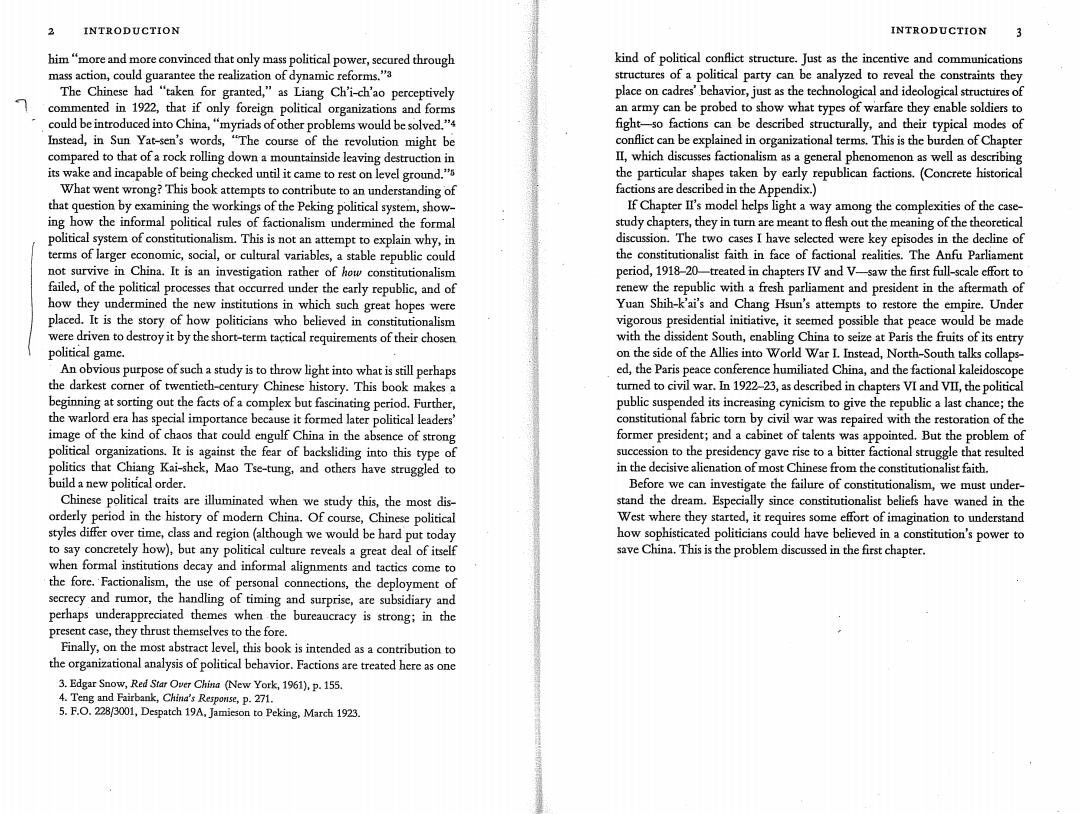正在加载图片...

INTRODUCTION INTRODUCTION 3 him"more and more convinced that only mass political power,secured through kind of political conflict structure.Just as the incentive and communications mass action,could guarantee the realization of dynamic reforms."3 structures of a political party can be analyzed to reveal the constraints they The Chinese had "taken for granted,"as Liang Ch'i-ch'ao perceptively place on cadres'behavior,just as the technological and ideological structures of commented in 1922,that if only foreign political organizations and forms an army can be probed to show what types of warfare they enable soldiers to could be introduced into China,"myriads of other problems would be solved." fight-so factions can be described structurally,and their typical modes of Instead,in Sun Yat-sen's words,"The course of the revolution might be conflict can be explained in organizational terms.This is the burden of Chapter compared to that of a rock rolling down a mountainside leaving destruction in II,which discusses factionalism as a general phenomenon as well as describing its wake and incapable of being checked until it came to rest on level ground. the particular shapes taken by early republican factions.(Concrete historical What went wrong?This book attempts to contribute to an understanding of factions are described in the Appendix.) that question by examining the workings of the Peking political system,show- If Chapter II's model helps light a way among the complexities of the case- ing how the informal political rules of factionalism undermined the formal study chapters,they in turn are meant to flesh out the meaning of the theoretical political system of constitutionalism.This is not an attempt to explain why,in discussion.The two cases I have selected were key episodes in the decline of terms of larger economic,social,or cultural variables,a stable republic could the constitutionalist faith in face of factional realities.The Anfu Parliament not survive in China.It is an investigation rather of how constitutionalism period,1918-20-treated in chapters IV and V-saw the first full-scale effort to failed,of the political processes that occurred under the early republic,and of renew the republic with a fresh parliament and president in the aftermath of how they undermined the new institutions in which such great hopes were Yuan Shih-k'ai's and Chang Hsun's attempts to restore the empire.Under placed.It is the story of how politicians who believed in constitutionalism vigorous presidential initiative,it seemed possible that peace would be made were driven to destroy it by the short-term tactical requirements of their chosen with the dissident South,cnabling China to seize at Paris the fruits of its entry political game. on the side of the Allies into World War I.Instead,North-South talks collaps- An obvious purpose of such a study is to throw light into what is still perhaps ed,the Paris peace conference humiliated China,and the factional kaleidoscope the darkest corner of twentieth-century Chinese history.This book makes a turned to civil war.In 1922-23,as described in chapters VI and VII,the political beginning at sorting out the facts of a complex but fascinating period.Further, public suspended its increasing cynicism to give the republic a last chance;the the warlord era has special importance because it formed later political leaders' constitutional fabric torn by civil war was repaired with the restoration of the image of the kind of chaos that could engulf China in the absence of strong former president;and a cabinet of talents was appointed.But the problem of political organizations.It is against the fear of backsliding into this type of succession to the presidency gave rise to a bitter factional struggle that resulted politics that Chiang Kai-shek,Mao Tse-tung,and others have struggled to in the decisive alienation of most Chinese from the constitutionalist faith. build a new political order. Before we can investigate the failure of constitutionalism,we must under- Chinese political traits are illuminated when we study this,the most dis- stand the dream.Especially since constitutionalist beliefs have waned in the orderly period in the history of modern China.Of course,Chinese political West where they started,it requires some effort of imagination to understand styles differ over time,class and region(although we would be hard put today how sophisticated politicians could have believed in a constitution's power to to say concretely how),but any political culture reveals a great deal of itself save China.This is the problem discussed in the first chapter. when formal institutions decay and informal alignments and tactics come to the fore.Factionalism,the use of personal connections,the deployment of secrecy and rumor,the handling of timing and surprise,are subsidiary and perhaps underappreciated themes when the bureaucracy is strong;in the present casc,they thrust themselves to the fore. Finally,on the most abstract level,this book is intended as a contribution to the organizational analysis of political behavior.Factions are treated here as one 3.Edgar Snow,Red Star Over China (New York,1961),p.155. 4.Teng and Fairbank,China's Resporse,p.271. 5.F.O.228/3001,Despatch 19A.Jamieson to Peking,March 1923